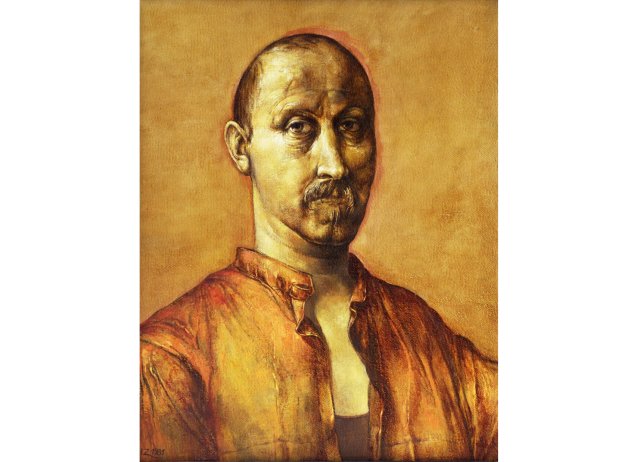Heinz Zander, self-portrait, oil on canvas, 1981
Photo: © 2012 Andreas Kämper
The formula “modern art” cannot capture much of art. Goethe’s understanding of art takes a closer look at how artists became students of previous artists: “There is a filiation throughout all of art.” What it means to immerse oneself in tradition as an artist is shown, for example, in a self-portrait by Heinz Zander with the confessional title “Even with an autumnal palette as a student of Hyacinthe Rigaud” (private collection). In its tradition and old master virtuosity, Zander’s art mocks the glut of self-referential and short-term innovations of “modern art.” Zander was visited by graces from the Early Renaissance, Mannerism and Symbolism, smilingly admitted by the artist’s own grace. The fantastic realist from Leipzig continues to inspire with the constantly renewed imaginative power of his visual language, with the full, sensual presence of the stretched and curved figures, with excitingly staged events in bright colors and the fascinating materiality of things. In 1965, the art historian Dieter Gleisberg staged Zander’s “magical magic game” in the first solo exhibition in the Lindenau Museum in Altenburg.
On the occasion of his 85th birthday, the Angermuseum Erfurt is now showing all of Heinz Zander’s paintings, graphics and hand drawings for the first time, including the portrait of Sonja Kehler, the self-portrait (1981) and mountain landscapes. Before 1989, no other artist from the Leipzig School received as much attention and appreciation in this institution as Heinz Zander. Curator Cornelia Nowak is dedicated to this topic, and she also contributed a detailed biography with a well-founded presentation of her work to the catalog. Hans Bruckschlegel’s explanation “Don’t mix, but glaze” from 1984 about the painting technique as an expressive value of Zander’s painting is also reprinted, as is Zander’s text “From the time of the early mothers. Theseus and Perseus” (1982).
The great exhibition, enriched with pictures from a number of locations and from the collection of supporter Peter Thoms from Mühlhausen, as well as the important catalog pay tribute to Zander’s work in the first decades of his work on literary material by Johann Wolfgang Goethe, Thomas Mann (“Dr. Faustus”) , 1964-67) to Bertolt Brecht (“Anachronistic Train”, 1984). Promoted by state commissions, historical events played an important role in Zander’s work – such as the Thuringian peasant uprisings in 1525 or the revolt of the city population of Erfurt against their councilors in 1509, which went down in history as the “Great Year of Erfurt”. The art historian Thomas von Taschitzki also explains the Augustinian monk Martin Luther’s vivid opposition to indulgences. Since Luther gave a sermon in the Barfüsserkirche in Erfurt, which had already become Protestant in 1525, Hein Zander’s Luther triptych has a connection to his biography.
Gerd Lindner keeps an extensive collection in the Bad Frankenhausen Panorama Museum. In the catalog he examines Zander’s journey through life in a far-reaching and profound way, and also how the artist subtly heightens expression in allegory-like, antithetical condensation and skillfully refines spiritual penetration using the means of irony. The author of this text demonstrates Zander’s innovative reference to mythology using Theseus, Perseus and centaurs, for example how Apollo carves the female Marsyas with a fine knife and removes the textile skin. “The literary is the most noble thing in art,” is one of Zander’s aphorisms, which does not mean literary work, which he also mastered, but the literary within the visual arts. Zander never understands this to be a “clumsy depiction of a prescribed thought,” but rather an image poem that finds meaning in a form. Anyone who, limited by the idea of cleanliness, considers literary elements in the visual arts to be an impermissible mixture is missing something. This art form goes back far into the Middle Ages.
Before he became a protagonist of contemporary realistic art in Europe, Heinz Zander had already impressed people with his outstanding achievements during his studies in Leipzig (1959–1964) and as a master student with Fritz Cremer. Even the teaching staff in Leipzig, looking over this student’s shoulder, were taught about drawing. The exhibition visitor is amazed: For example, at the fact that the person who begs for money believes that he can teach the world (in a painting from 1989), and also at the color art: how madder lacquer and Parisian blue shimmer in the black background.
»Heinz Zander. Time and Dream”, until July 28th, Angermuseum Erfurt
Become a member of the nd.Genossenschaft!

Since January 1, 2022, the »nd« will be published as an independent left-wing newspaper owned by the staff and readers. Be there and support media diversity and visible left-wing positions as a cooperative member. Fill out the membership form now.
More information on www.dasnd.de/genossenschaft
judi bola online sbobet judi bola judi bola online
